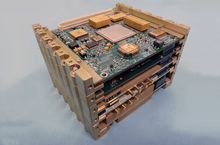Iris (transponder)
The Iris transponder is a small, low power deep-space transponder designed by JPL for use in cubesats.[1][2] It unifies a number of communication functions - receiver, command detector, telemetry modulator, exciters, and control functions - into one 1.2-kg package that occupies about 0.5 U. IRIS is designed to handle X band uplink, UHF receive, and both X band and optional Ka band downlink. It is only one third the mass, and lower power, compared to the smallest previous solution, the small deep space transponder.

The Iris transponder for deep space communication
Functions
The capabilities of Iris include:[1]
- X-band receiver/downconverter capable of carrier tracking.
- Command detector unit function.
- Telemetry modulation function.
- X-band exciter.
- A matching X-band power amplifier and low-noise amplifier.
- X-band ranging.
- UHF (390-450 MHz) receiver for communication with landers/rovers.
- Differential one-way ranging (DOR) at X-band.
- Uplink: TC Space Data Link Protocol - CCSDS 232.0-B-3
- Downlink: AOS Space Data Link Protocol = CCSDS 732.0-B-3
- Supports codes Convolutional 7-1/2, Manchester, Bi-Phase, and bypass (NRZ), Reed Solomon (255,223), Turbo codes with rates 1/2, 1/3, and 1/6 (block size 8920 bits)
- Interface to rest of CubeSat electronics is through Serial Peripheral Interface Bus, with a special hardwired output to reset the CubeSat.
Missions
gollark: Oh, you didn't work out the challenge then.
gollark: Any recent thing will be 64 bit and I believe most docker images are built for that.
gollark: Or give it to everyone and hope they add it.
gollark: I could write a script to harvest data from the system environment and anonymously upload it and randomly give it to someone to add to their thing.
gollark: Indeed.
See also
References
This article is issued from Wikipedia. The text is licensed under Creative Commons - Attribution - Sharealike. Additional terms may apply for the media files.